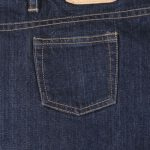Jeans come in many different types. While you might be familiar with boot-cut and skinny, there are many other types of jeans, one of which being corduroy stretch jeans. Corduroy stretch jeans look like traditional jeans from afar. When inspecting them up close, however, you’ll notice they have a ribbed surface. But that’s not the only characteristic which defines them. Corduroy stretch jeans are distinguished from traditional jeans in a few other ways. What are corduroy stretch jeans exactly?
What Are Corduroy Stretch Jeans?
Corduroy stretch jeans are a relatively new type of jeans that are made of stretch denim with a corduroy-style weaving pattern. All corduroy stretch jeans are made of stretch denim. That’s why they are known as “stretch” corduroy jeans.
Stretch denim is a type of material consisting of cotton and an elastic fabric. Like regular denim, stretch denim is comprised mostly of cotton. It typically has about 97% to 99% cotton. For its elastic properties, though, stretch denim contains an elastic fabric as well. Some types of stretch denim use polyester, whereas other types use lycra. Regardless, they all contain an elastic fabric. Even when used in small amounts, an elastic fabric changes the physical properties of denim. It makes the denim stretchier and more elastic, thus converting traditional denim into stretch denim.
Of course, corduroy stretch jeans aren’t defined solely by their use of stretch denim. As the name suggests, they feature a corduroy-style weaving pattern. Many people assume that corduroy is a specific type of fabric, but this isn’t necessarily true. Corduroy is actually a weaving pattern.
Some of the most common corduroy weaving patterns include the following:
- Standard Wale
- Pincord or Needlecord
- Printed
Corduroy Stretch Jeans vs Traditional Jeans
Traditional jeans differ from corduroy jeans in several ways. For starters, they are typically made of regular denim. Regular denim is made entirely of cotton. It doesn’t contain polyester, lycra or any other elastic fabric. Regular denim is made of 100% cotton that’s woven to achieve a superior level of stretch and durability.
You can still find traditional jeans made of stretch denim. Known as stretch jeans, they offer a versatile alternative. Nonetheless, most traditional jeans are made of regular denim, which consists entirely of cotton and without any elastic fabric.
Traditional jeans also have a different weaving pattern than corduroy stretch jeans. If you rub your hands against the surface of corduroy stretch jeans, you’ll probably discover they are ribbed. As shown in the adjacent photo, corduroy stretch jeans have a textured surface that’s defined by parallel ribs or ridges. This pattern is achieved through weaving, which is one of the ways that corduroy stretch jeans are distinguished from traditional jeans.

Benefits of Corduroy Stretch Jeans
You can’t go wrong with a pair of high-quality corduroy stretch jeans. They offer a unique style that’s not found in traditional jeans. Most traditional jeans look the same. While available in a variety of colors, they are typically made of the same denim material and feature the same weaving pattern. Corduroy stretch jeans offer a breath of fresh air. They feature a different material as well as a different weaving pattern.
Corduroy stretch jeans are also resistant to wrinkles. They can still develop wrinkles — wrinkles can occur in all types of trousers and other garments. With that said, corduroy stretch jeans offer a higher level of protection against wrinkles than traditional jeans. This is because corduroy stretch jeans have a ribbed surface. The ribbed surface acts as a deterrent to wrinkles.
Like all jeans made of stretch denim, corduroy stretch jeans are exceptionally comfortable. Most people will agree, in fact, that they are more comfortable than traditional jeans. With corduroy stretch jeans, you’ll benefit from an exceptional level of comfort. They are softer and more elastic than traditional jeans. As a result, you can wear them for long periods without worrying about irritation or discomfort. All corduroy stretch jeans are soft, elastic and ultra-comfortable to wear.
How to Choose Corduroy Stretch Jeans
Not all corduroy stretch jeans are made equal. If you’re going to buy a pair of corduroy stretch jeans, you should choose the right type. For starters, you should consider the color. You can find corduroy stretch jeans in dozens of colors. Blue is probably the most popular color. Corduroy stretch jeans are available in light blue and indigo blue, both of which are excellent choices. However, you can find them in other colors like red, green, black and white.
You should also consider the cut when choosing corduroy stretch jeans. Corduroy stretch jeans are available in many of the same cuts as their traditional counterparts. The “cut” refers to the way in which the jeans are designed to sit or rest on your body when worn. There are skinny jeans, for instance, that run straight through the legs with a narrow opening. There are also boot-cut jeans that, as you may already know, have a tapered bottom so that they can be easily worn with boots.
Don’t forget to choose a pair of corduroy stretch jeans in the right size. You can’t expect to get much use out of them if they don’t fit. Maybe you accidentally choose a size too big, or perhaps you choose a size too small. Regardless, corduroy stretch jeans in the wrong size won’t be comfortable to wear. You can avoid this headache, fortunately, by ordering a pair of custom-sized corduroy stretch jeans.
Custom-sized corduroy stretch jeans are designed using your own body measurements. You can order them here at MakeYourOwnJeans. We offer custom sizing on all our jeans, including corduroy stretch jeans, at no additional charge. You don’t have to choose a generic size. Rather, you can specify your body measurements when ordering corduroy stretch jeans. With custom sizing, they’ll fit perfectly to provide the utmost level of comfort and aesthetics.











